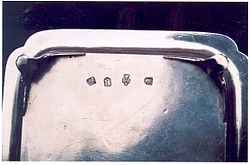Britannia silver

Britannia silver is a designation for an alloy of silver introduced in the United Kingdom in 1697 , in the style of the standard for the better-known sterling silver . The name goes back to the determination of the alloy proportions: One pound of Britannia silver was composed of eleven British ounces of fine silver and ten silver pennies , on which the Britannia was depicted at the time . This corresponds to a fineness of 95.83% silver. The rest is usually copper, like sterling silver. For comparison - sterling silver, also known as "Silver 925": 92.5% silver, 7.5% copper.
Britannia silver was introduced as part of the great minting reform under King Wilhelm III in 1696 to replace sterling silver , which until then was the valid standard for objects made of silver sheet. As the hallmark of the border erected lion as a trademark for sterling silver was punched Britannia Silver with the figure of Britannia.
Since the purer Britannia silver is much softer than the more copper-containing sterling silver, sterling silver was again declared the binding standard on June 1, 1720. In addition, Britannia silver remained a permitted hallmark in the United Kingdom and Ireland until January 1, 1999 .
With the introduction of the international designation "958", compared to Britannia silver, 0.03% fineness and, with the hallmark 958 , the figure of Britannia was largely dispensed with. The silver bullion coin Britannia of the Royal Mint , introduced in 1997, was minted in Britannia silver up to and including 2012.
Britannia silver should not be confused with Britannia metal, a tin alloy with no silver content.
Individual evidence
- John Forbes: Hallmark: A History of the London Assay Office . Unicorn Press Ltd, London 1999, ISBN 9780906290262 .